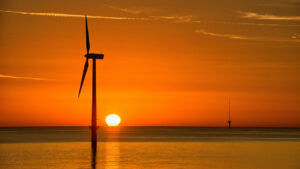THE Department of Energy (DoE) said it is projecting more than 16 gigawatts (GW) of new capacity from offshore wind power projects.
The DoE said it is currently assisting 16 offshore wind proponents who committed to start construction by 2027 and to deliver the first kilowatt-hour by 2028.
The largest project is Domhain Earth Corp.’s Bulalacao Offshore Wind Farm in Oriental Mindoro and Antique with capacity of 3,100 megawatts (MW).
Other large-scale projects are the 1,830-MW Calatagan Offshore Wind Farm in Batangas and Mindoro; the 1,600-MW Claveria Offshore Wind Farm in Ilocos Norte and Cagayan; and the 1,500-MW Mariveles Offshore Wind Farm in Bataan, Cavite and Batangas.
The DoE has also recognized BuhaWind Energy Northern Luzon Corp.’s 2,000-MW Northern Luzon Offshore Wind Power Project in Ilocos Norte as a so-called “frontrunner project.”
Other offshore wind project include CI NMF (PH) Corp.’s 1,000-MW San Miguel Bay Offshore Wind Power Project in Camarines Norte and Camarines Sur; the 650-MW Samar Norte Offshore Wind Power Project in Northern Samar; and the 350-MW Dagupan Offshore Wind Power Project in Pangasinan and La Union.
The other frontrunners include Vind Energy Corp.’s 994-MW Cavite Offshore Wind Project and the 728-MW GS2 Offshore Wind Power Project in Guimaras; Triconti SouthWind Corp.’s 600-MW Guimaras Strait Wind Power Project; and Jet Stream Windkraft Corp.’s 600-MW Guimaras Strait II Wind Power Project.
Also designated frontrunner projects are Ivisan Windkraft Corp.’s 450-MW Frontera Bay Wind Power Project in Bataan and Cavite and ACX3 Capital Holdings, Inc.’s 500-MW San Miguel Bay Wind Power Project in Camarines Sur, 475-MW Lucena Wind Power Project in Quezon, and 275-MW Tayabas Bay Wind Power Project in Quezon.
The DoE is hoping to stage the fifth round of the green energy auction (GEA-5) focused on offshore wind power this year, Undersecretary Rowena Cristina L. Guevara said.
“We announced this in December because some of the front-runner offshore wind projects needed to assure their investors that the Green Energy Auction 5 is going to happen,” Ms. Guevara told reporters last week.
GEA-5 is expected to secure market access for offshore wind developers, ensuring long-term demand for their generation capacities and keep them on track to generate the first kilowatts by 2028.
The government had awarded 92 offshore wind contracts with 68-GW potential capacity as of October. Of the total, 21 contracts were awarded to foreign-owned companies with an aggregate capacity of 19.2 GW.
However, for these projects to be realized, ports need to be developed to serve as logistics hubs throughout the lifecycle of the projects.
Ms. Guevara said that transmission and ports are the crucial components of offshore wind development. The DoE is currently working with the National Grid Corp. of the Philippines for the transmission and local government units for right of way.
The department is also in talks with the Department of Environment and Natural Resources (DENR) and the Philippine Ports Authority (PPA).
The PPA has committed and allocated a budget for repurposing and expansion of three priority ports. Due to their proximity to high-potential wind energy service contracts, Currimao port in Ilocos Norte, the Port of Batangas, and the Jose Panganiban port in Camarines Norte have been identified as critical to offshore wind development.
In October, the DoE and the DENR signed a memorandum of agreement allowing access to both offshore and auxiliary areas during the pre-development/exploration, development and commercial development phases, subject to the necessary DENR requirements.
“Our move is really coordinated because we want to succeed,” Ms. Guevara said.
The Philippines’ offshore wind resources are estimated at a potential 178 GW, according to the World Bank’s 2022 Offshore Wind Roadmap for the Philippines. — Sheldeen Joy Talavera

